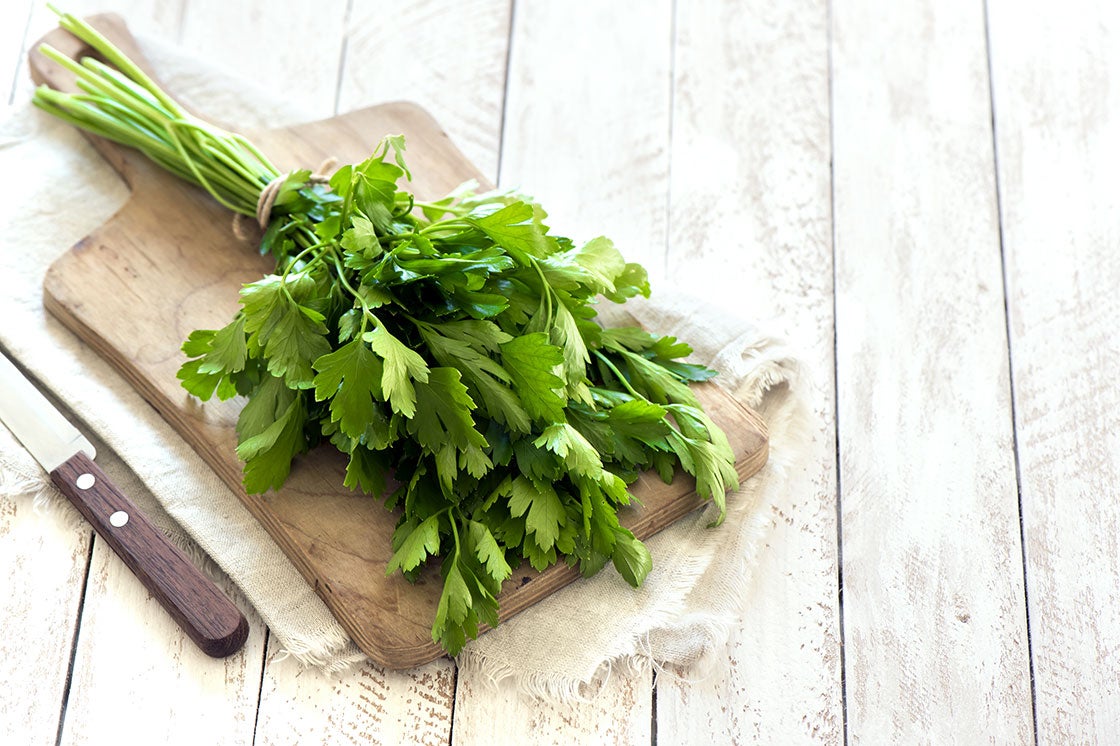Flavors - Parsley

With star chefs scattering cilantro over everything in sight and singing the praises of exotic herbs such as shiso and winter savory, it’s easy to overlook plain parsley. But modern foodies aren’t the only ones guilty of giving parsley the short end of the spoon. Way back in the 17th century, the English botanist John Parkinson wrote, “Our common Parsley is so well known, that it is almost needless to describe it.” Add to that those ubiquitous sprigs and sprinklings in restaurants and you might think that this familiar herb is more decorative than delicious. Not so.
“There’s a long tradition of seasoning foods with parsley, both to complement other herbs and spices and to perk up blander fare such as potatoes, grains and pasta,” says Tim Haas, coauthor of Basil to Thyme: Culinary Endeavors from the Garden to the Kitchen. “It drives me crazy to hear TV cooking show hosts talk about adding parsley for color. You should add parsley for flavor!”
“Fresh” is the word most often used to describe parsley’s taste, but it’s also slightly peppery and almost anise-like when used by itself to season dishes. More often than not, however, parsley is paired with other seasonings to round them out and deepen their flavors. One reason parsley goes well with other herbs and spices is that it’s the “parent” of a plant family that includes anise, caraway, cumin, celery, cilantro, chervil, dill and fennel. That means parsley’s milder, sweeter flavor won’t interfere with any of these herbs (or many others, for that matter); rather, it enhances them.
In France, stocks and stews almost always begin with a bouquet garni—three sprigs of parsley tied together with a bay leaf and a branch of thyme. Fines herbes, another French culinary staple composed of equal parts parsley, tarragon, chervil and chives, is sprinkled on soft goat cheese, steamed vegetables and omelets. “Just about every Italian recipe calls for some kind of parsley,” Haas adds, citing minestrone, the vegetable soup whose key herb is chopped parsley, and gremolata, a garnish made with parsley, garlic and lemon zest that’s sprinkled over dishes just before they’re served.
And what would tabbouleh be without lots of parsley to add sharp freshness to the combination of bulgur, cucumbers, tomatoes and mint? Parsley also comes in handy for lightening up cold-weather dishes. It tames the bite of garlic and onions (and the bad breath—parsley’s high chlorophyll content is said to neutralize odors) and mellows more pungent herbs such as sage, rosemary, thyme and tarragon. It really shines when used in everyday dishes that need a little oomph, such as steamed rice or carrots.
Or those end-of-the-winter vegetables and so-so salad greens that could use a little crisp flavor. Parsley makes a tasty filler when you don’t have quite enough basil for a recipe, and a quarter cup of chopped parsley stirred into prepared tomato sauce, salsa or soup instantly eliminates that “store-bought” taste. Just be sure to add chopped parsley to hot foods right before serving—it loses its flavor and color when exposed to heat for long periods of time.
Curly parsley used to be the easiest type to find in the United States, and it’s often the cheapest, although the availability of flat-leaf (or Italian) parsley is improving, thanks to chefs and cooks who prefer its somewhat stronger flavor and softer, flatter, easier-to-chop leaves. The two parsleys are interchangeable in most recipes, so your best bet when shopping is to simply buy the bunch that looks freshest. No matter what variety you choose, get in the habit of having parsley on hand. Unlike those tiny boxes of fancy herb sprigs—which can get expensive, especially out of season—a big bunch of parsley sells for about a dollar year-round, so you can use it as lavishly as you like. As fresh herbs go, that’s rare enough to make plain parsley pretty remarkable.
Alsatian Parsley Salad Sandwiches
Makes 6 sandwiches
30 minutes or fewer
In Alsace, a province in the northeastern part of France, this cheese salad is served as a (very hearty!) first course. The large amount of parsley used adds a fresh, green flavor that brings out the creaminess of the cheese. Once you’ve tried it between two slices of bread, you’ll never think of cheese sandwiches in the same way again.
2 Tbs. red wine or cider vinegar
1 Tbs. Dijon-style mustard
1/4 cup olive oil
2 cups grated Gruyère or Emmenthaler cheese (about 8 oz.)
1/2 cup chopped fresh parsley
2 shallots, finely chopped (about 1/4 cup)
12 slices crusty bread Lettuce and tomato slices for garnish, optional
1. Whisk together vinegar and mustard in medium bowl. Add oil and 2 Tbs. water, and whisk until combined. Stir in cheese, parsley and shallots, and toss until combined.
2. Spoon 1/3 cup cheese mixture onto each of 6 slices of bread. Garnish with lettuce and tomato, if desired, and top with remaining bread slices.
PER SERVING: 437 CAL; 17G PROT; 22.5G TOTAL FAT (8G SAT. FAT); 40G CARB; 40MG CHOL; 638MG SOD; 2G FIBER; 2G SUGARS